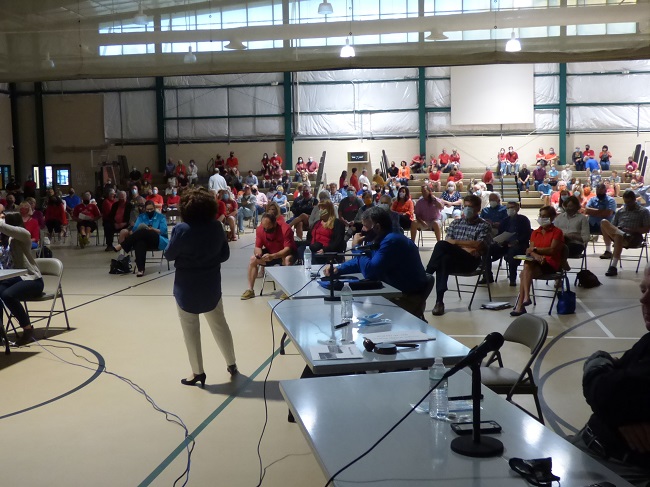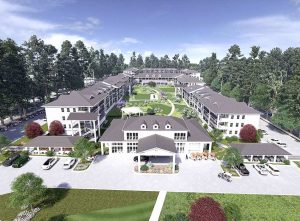A market analysis of the Livable Centers Initiative (LCI) process now underway for areas surrounding Ga. highways 54 and 74 in Peachtree City was presented Oct. 13 at the Kedron Fieldhouse. Many among the more than 350 people attending wanted to weigh-in on the LCI plan. That time will come on Oct. 22.
The market analysis presentation was not the final LCI plan. The plan will be part of a formal presentation to City Council on Oct. 22, held again at the Kedron Fieldhouse. The economic findings will be used to check the LCI plan, with the meeting also designed with venues for public input on the plan, said city Director of Planning and Development Robin Cailloux.
A list of implementation recommendations will be created based on the public participation exercise at the Oct. 22 meeting. There, the public will be asked to rank the implementation projects, Cailloux said.
Cailloux said the City Council will be the body responsible for deciding if the city will implement any of the LCI implementation recommendations that are within the area of public control.
“What I mean by that is that most of the land in the two remaining redevelopment areas are privately owned, and council cannot force property owners to redevelop their land. Most of the implementation recommendations for public land will fall to street projects and path projects,” Cailloux said. “But City Council is not obligated to do anything or make any official action, regardless of whether they adopt the LCI plan or not. Adoption of the LCI study is only necessary if the city wants to seek funding for transportation projects identified in the LCI plan.”
As for the market analysis on Oct. 13, throughout the presentation it was noted that “the market analysis helps us understand what we could do, not what we have to do.”
The 84-page LCI Market Analysis on the peachtreecitylci.com website under the presentations section can be viewed by clicking here.
Included in the market analysis was the change in buying habits that have occurred both locally and nationally, with Cailloux noting today’s heavy presence of online shopping and the major shift in the past 30 years from car-centric developments to the desire for walkable developments.
Though not part of the market analysis presentation, and though it was turned down by the council because they said it was in the wrong location, Peachtree City had the walkable Calistoa Lake McIntosh development proposal in 2019 that would have been a mini-village with a corporate headquarters, office, residential and retail on 28 acres adjacent to Lake McIntosh.
As for the LCI study area, it deals with the areas surrounding highways 54 and 74 in the center of the city. It is that area which has become a regional transportation problem with local impacts, Cailloux said, noting the plan by Ga. Department of Transportation to spend millions beginning in late 2021 to construct a displaced left-turn intersection at the site.
The idea behind the LCI study is to plan for the next 60 years in Peachtree City, with respect to property rights, responding to market trends and considering transportation project impacts, Cailloux said.
Cailloux said the goals of the LCI study, of which the market analysis is a part, include defining a walkable village center, creating new street/path connections, identifying potential redevelopment sites and creating a conceptual for those sites.
After those opening comments, Cailloux moved into the market analysis, which addressed four land use components — residential, office, retail and flex industrial.
The residential land use portion of the analysis showed Peachtree City with 9,851 owner-occupied housing units, 1,450 apartments and 1,895 other types of units, such as townhouses and condos. The report also noted that the City Council for years has not supported additional apartment projects in the city.
The analysis showed for-sale units needed to support job growth from 2020-2024 included 115-120 attached units due to space limitations and high land costs.
Looking at the demographics of Peachtree City renters, more than half have a household income of more than $50,000, and with a significant percentage of those with a household income of more than $100,000.
Pertaining to the age range of renters, it was essentially split between those age 35 or younger, those 35-54 and those 55 and older.
The office land use portion of the report showed 900,000 sq. ft. of existing office with a 9.8 percent vacancy. The average age of an office in Westpark is 20 years old, the report noted.
The study identified two things business tenants want. Those include being in proximity to population density and a walkable mixed-use setting. If both those criteria were met, the city could support one 50,000 sq. ft. office building.
The retail land use portion of the report showed retail vacancies currently at 5.9 percent, the same as in 2019. That compares to a low of 2.2 percent vacancies in 2017 and 2.3 percent in 2016. The highest vacancy rate was 8 percent in 2010, in the aftermath of the Great Recession.
The report showed that national retailers want customers (population density of 1,500 per square mile and incomes of $96,000 per year) and proximity to other retailers (close, but not too close).
Cailloux noted the shift by retailers responding to customers wanting a walkable shopping experience, adding that, “We saw that with The Avenue.”
The analysis projected the coming retail demand at 170,000 sq. ft. of specialty retail, with a focus on small grocer and specialty food and wine, restaurants and delis and small-scale retailers. The retail must be in a walkable mixed-use environment and possibly anchored by a specialty grocer.
The flex industrial land use portion of the market analysis described it as light industrial with options such as assembly, warehouse/office space, recreational/community space and some minor retail.
Flex industrial has a lower construction cost and is usually 1-2 stories and can include craft industries, artist’s studios, small start-ups and cottage industries. Flex space in Peachtree City currently has a 1.6 percent vacancy rate, cited as very low.
An example of flex industrial is Line Creek Brewing Company.
Flex space cited in the report noted the need for 120,000 sq. ft. in the LCI study area during 2020-2024.
The LCI grant program is managed by the Atlanta Regional Commission using federal transportation dollars. Like all federal grants, the local government must match 20 percent. The full grant is $160,000, with 80 percent, or $128,000 coming as federal money, and 20 percent, or $32,000, from Peachtree City.











Leave a Comment
You must be logged in to post a comment.